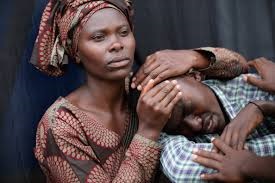Photo: KIGALI, RWANDA - APRIL 07: A woman consoles Bizimana Emmanuel, 22, during the 20th anniversary commemoration of the 1994 genocide at Amahoro Stadium April 7, 2014 in Kigali, Rwanda. Thousands of Rwandans and global leaders, past and present, joined together at the stadium to remember the country's 1994 genocide, when more than 800,000 ethnic Tutsi and moderate Hutus were slaughtered over a 100 day period. (Photo by Chip Somodevilla/Getty Images)
Declassified U.S. documents show the Clinton administration refused to label the 1994 mass killings in Rwanda as a genocide. One State Department document read: "Be careful … Genocide finding could commit U.S.G. to actually 'do something.'" At a press briefing in 1994, Reuters correspondent Alan Elsner asked: "How many acts of genocide does it take to make genocide?" State Department spokesperson Christine Shelly responded, "Alan, that’s just not a question that I’m in a position to answer." Samantha Power, who is now the U.S. ambassador to the United Nations, described the U.S. inaction in her 2001 article, "Bystanders to Genocide." She wrote, "The United States did much more than fail to send troops. It led a successful effort to remove most of the UN peacekeepers who were already in Rwanda. It aggressively worked to block the subsequent authorization of UN reinforcements." We speak to Emily Willard of the National Security Archive, and University of Wisconsin, Madison, Professor Scott Straus, author of "The Order of Genocide: Race, Power, and War in Rwanda."
 The Truth About Boko Haram & #BringBackOurGirls
The Truth About Boko Haram & #BringBackOurGirls 








